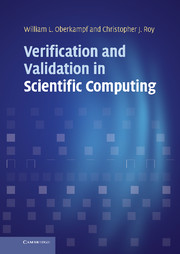Book contents
- Frontmatter
- Contents
- Preface
- Acknowledgments
- 1 Introduction
- Part I Fundamental concepts
- Part II Code verification
- Part III Solution verification
- 7 Solution verification
- 8 Discretization error
- 9 Solution adaptation
- Part IV Model validation and prediction
- Part V Planning, management, and implementation issues
- Appendix Programming practices
- Index
- Plate Section
- References
7 - Solution verification
from Part III - Solution verification
Published online by Cambridge University Press: 05 March 2013
- Frontmatter
- Contents
- Preface
- Acknowledgments
- 1 Introduction
- Part I Fundamental concepts
- Part II Code verification
- Part III Solution verification
- 7 Solution verification
- 8 Discretization error
- 9 Solution adaptation
- Part IV Model validation and prediction
- Part V Planning, management, and implementation issues
- Appendix Programming practices
- Index
- Plate Section
- References
Summary
Solution verification addresses the question of whether a given simulation (i.e., numerical approximation) of a mathematical model is sufficiently accurate for its intended use. It includes not only the accuracy of the simulation for the case of interest, but also the accuracy of inputs to the code and any post-processing of the code results. Quantifying the numerical accuracy of scientific computing simulations is important for two primary reasons: as part of the quantification of the total uncertainty in a simulation prediction (Chapter 13) and for establishing the numerical accuracy of a simulation for model validation purposes (Chapter 12).
Most solution verification activities are focused on estimating the numerical errors in the simulation. This chapter addresses in detail round-off error, statistical sampling error, and iterative convergence error. These three numerical error sources should be sufficiently small so as not to impact the estimation of discretization error, which is discussed at length in Chapter 8. Discretization errors are those associated with the mesh resolution and quality as well as the time step chosen for unsteady problems. Round-off and discretization errors are always present in scientific computing simulations, while the presence of iterative and statistical sampling errors will depend on the application and the chosen numerical algorithms. This chapter concludes with a discussion of numerical errors and their relationship to uncertainties.
- Type
- Chapter
- Information
- Verification and Validation in Scientific Computing , pp. 250 - 285Publisher: Cambridge University PressPrint publication year: 2010



